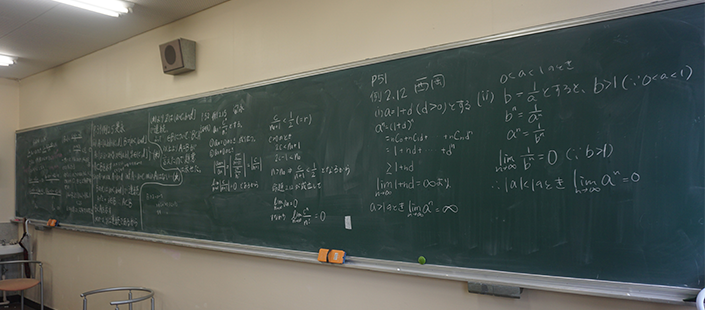- Top
- Mathematics
ページの本文です。

Mathematics
Mathematics
Mathematics Is the Language of the Scientific World
Touch the Ever-Advancing Beauty of Mathematics
Mathematics is the language of the scientific world—an indispensable tool for expressing quantitative and diagrammatic information, of course in natural sciences, as well as in the social sciences and other scientific fields.
Students learn the basics of modern mathematics, master the ability to think mathematically, and touch the beauty of mathematics that continues to blossom on a daily basis.
During the program’s first year and the first half of the second year, students discover how to think mathematically and how to frame mathematical concepts. They also discover how interesting and useful mathematics is.
From the second half of the second year, students focus their energies on grasping the basics of the algebra, geometry and analysis necessary to every area of mathematics.
Third-year students attend lectures and seminars in a wide range of areas, and fourth-year students attend the Seminar on Mathematics. The research of teachers offered covers a wide range of mathematical fields.
Objective: Cultivate Your Talent and Boost Your Employment Prospects
The goal of the Mathematics program is to cultivate people who can independently contribute to society, including teachers who can devise their own educational content, creative professionals with specialized skills, and researchers who pursue basic research.
The program’s goals are to provide women eager to learn about and research mathematics with a core education in modern mathematics and develop the basics that help students to become advanced professionals as well as researchers with the ability to continue learning on their own. Another goal is to produce graduates that can play a positive role in society by having students master mathematical theoretical thinking through the Seminar on Mathematics and other courses.
Roughly equal numbers of graduates over the past several years have gone on to enter the workforce or pursued higher education, although increasing numbers are entering graduate school. Major employers include information and communications firms, financial corporations, middle and high schools (teachers), and the civil service. Employment prospects are excellent, and every student who seeks employment finds a position.
Features: Comprehensive Support through Small-Class Education
Specialized courses start from April of the first year. The enrollment limit for first-year students is twenty, including compulsory courses. Electives tend to have even smaller class sizes. Teachers pay closer attention to students.
One teacher is placed in charge of two or three students as a supervisor that advises them on studies and general life issues and provides even more detailed instruction.
Fourth-year students take the compulsory Seminar on Mathematics course taught by teachers of their own choosing in small groups of four or less. At the end of the school year, there is a seminar where students present the results of their research. In general, courses are conducted with students explaining the contents based on theses and treatises they’ve read, using the blackboard and other means in front of their instructors.
Group Theory 1
Group theory algebraically describes the symmetry of various mathematical objects. Students learn the definition of a group along with representative examples, and study the fundamental theorem on homomorphism, the structural theorem for finitely generated abelian groups, and other fundamental theories.
Elementary Complex Analysis
Students learn about complex-valued functions defined on the complex plane, especially the fundamental properties of regular functions. Students mainly use Cauchy’s succinct and powerful integral theorem, as well as other related theorems.
Manifold
A manifold is a generalized concept of curved lines and surfaces. Students learn the basics of functions, mapping, tangent vectors, vector fields and other topics that are defined based on manifolds.
General Topology
Sequence convergence and function continuity are defined based on the concept of proximity. Students learn the basics of distance structure and topological structure, which generalize and abstract the concept of proximity.
Probability Theory
This course is an introduction to modern probability theory as a rigorous form of mathematics based on measure theory, including the law of large numbers, the central limit theorem, and various other limit theorems.







